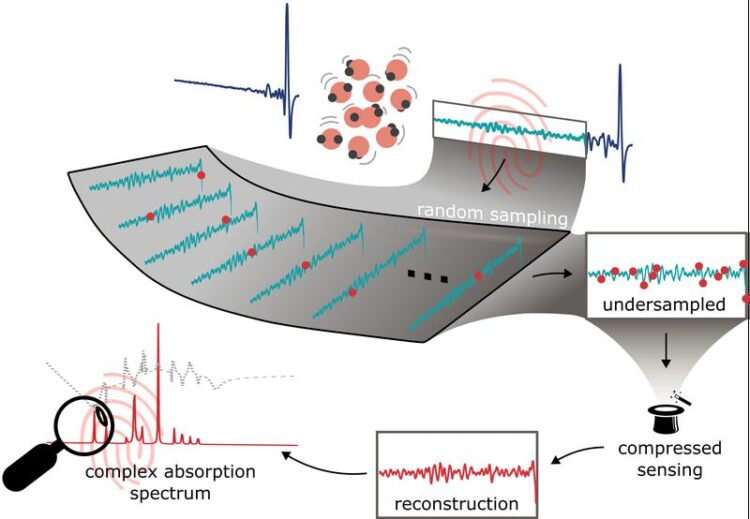Molecular Fingerprint Beyond the Nyquist Frequency

Visual summary of compressed sensing of field-resolved molecular fingerprints. Reprint from DOI: 10.34133/ultrafastscience.
@ Hanieh Fattahi / MPL Reprint from DOI: 10.34133/ultrafastscience
Ultrafast laser spectroscopy allows the ascertainment of dynamics over extremely short time scales, making it a very useful tool in many scientific and industrial applications. A major disadvantage is the considerable measuring time this technique usually requires, which often leads to lengthy acquisition times spanning minutes to hours. Researchers have developed a technique to speed up spectroscopic analysis. The results of the project led by Hanieh Fattahi, Research group leader at the Max-Planck-Institute of the Science of Light, in collaboration with industrial partners from Germany and France, were recently published in the Journal of Ultrafast Science.

Research Group Leader Dr. Hanieh Fattahi (right) together with Kilian Scheffter (left) in the lab. @Susanne Viezens ⁄ MPL
Ultrashort pulses play a significant role in spectroscopic applications. Their broad spectral bandwidth enables simultaneous characterization of the sample at various frequencies, eliminating the need for repeated measurements or laser tuning. Moreover, their extreme temporal confinement allows for temporal isolation of the sample’s response from the main excitation pulse. This response, which carries comprehensive spectroscopic information lasts from tens of femtoseconds to nanoseconds (10−15 to 10−9 seconds) and is commonly probed by a shorter pulse at various time delays. When merged with other techniques, such as multi-dimensional coherent spectroscopy or hyperspectral imaging, ultrafast spectroscopy facilitates the identification of unknown constituents. However, the ambition of real-time measurements faces obstacles, primarily due to the extensive data recording required across the high bandwidth spectrum for each pixel, introducing considerable delays in data capture, extending processing time, and increasing data volume.
Researchers have developed a technique to speed up spectroscopic analysis. Kilian Scheffter, a doctoral student working with Hanieh Fattahi, head of the “Femtosecond Fieldoscopy” group at MPL explains: ”The response of molecules to ultrashort excitation pulses is typically sparse in many samples, which implies that the response occurs only at specific frequencies known as molecular fingerprints. By strategically randomizing the measurement points in time, an established approach called compressed sensing can efficiently reconstruct the signal by using fewer data points than the limit dictated by the Nyquist criterion. However, the main challenge has been to change the temporal overlap of the probe pulses and the femtosecond excitation pulses randomly. Collaborating with our partners in Germany and France, we’ve successfully employed acoustic waves to modulate this temporal overlap randomly. This innovation expands the application of compressed sensing to real-time spectroscopic measurement.”
“Accelerating time domain spectroscopy offers several advantages, for example in simplifying the label-free imaging of fragile specimens, real-time environmental monitoring and open-air diagnostics of toxic and hazardous gases, and molecular fieldoscopy” says Dr. Hanieh Fattahi.
Wissenschaftliche Ansprechpartner:
Dr. Hanieh Fattahi / Research group leader
“Femtosecond Fieldoscopy” at the Max Planck Institute for the Science of Light, Erlangen
www.mpl.mpg.de / hanieh.fattahi@mpl.mpg.de
Originalpublikation:
Original publication in Ultrafast Science:
Kilian Scheffter, Jonathan Will, Claudius Riek, Herve Jousselin, Sebastien Coudreau, Nicolas Forget, Hanieh Fattahi “Compressed Sensing of Field-resolved Molecular Fingerprint Beyond the Nyquist Frequency”, Ultrafast Science (2024).
DOI: 10.34133/ultrafastscience.0062
https://spj.science.org/doi/10.34133/ultrafastscience.0062
Media Contact
All latest news from the category: Physics and Astronomy
This area deals with the fundamental laws and building blocks of nature and how they interact, the properties and the behavior of matter, and research into space and time and their structures.
innovations-report provides in-depth reports and articles on subjects such as astrophysics, laser technologies, nuclear, quantum, particle and solid-state physics, nanotechnologies, planetary research and findings (Mars, Venus) and developments related to the Hubble Telescope.
Newest articles

Innovative 3D printed scaffolds offer new hope for bone healing
Researchers at the Institute for Bioengineering of Catalonia have developed novel 3D printed PLA-CaP scaffolds that promote blood vessel formation, ensuring better healing and regeneration of bone tissue. Bone is…

The surprising role of gut infection in Alzheimer’s disease
ASU- and Banner Alzheimer’s Institute-led study implicates link between a common virus and the disease, which travels from the gut to the brain and may be a target for antiviral…

Molecular gardening: New enzymes discovered for protein modification pruning
How deubiquitinases USP53 and USP54 cleave long polyubiquitin chains and how the former is linked to liver disease in children. Deubiquitinases (DUBs) are enzymes used by cells to trim protein…


